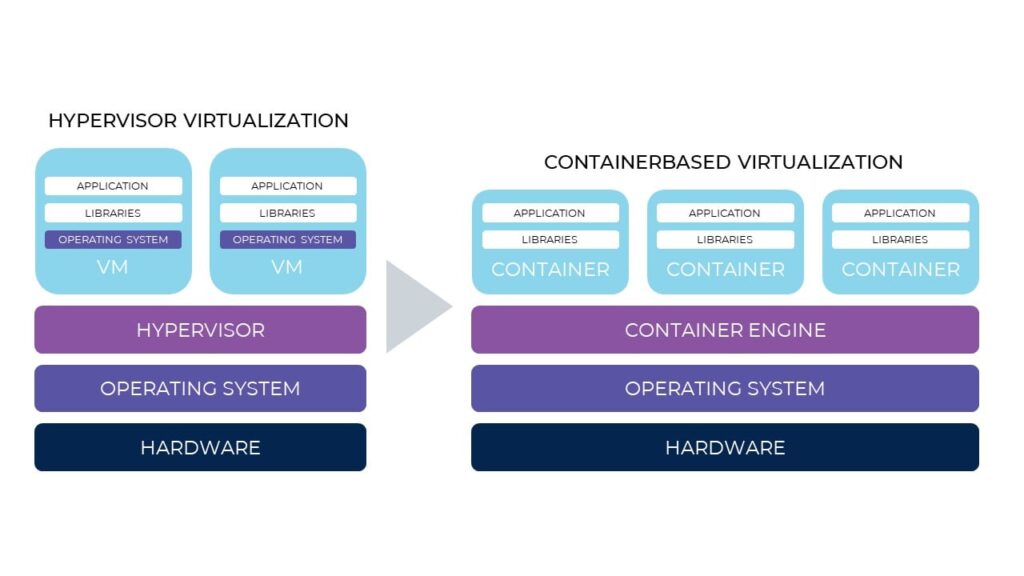Stephan Bienek provides insight into the world of container technology.
Berlin – 05.11.2021

Stephan Bienek
Head of Hosting
Stephan has been part of the bright minds at weSystems since 2020. He brings experience from over 15 years in the field of solution consulting and supports our customers in all IT-related challenges
What does Container as a Service mean?
Container as a Service, abbreviated CaaS, basically describes a cloud computing model that provides a platform for running Containers as a Service. At weSystems, we offer an orchestration platform on which containers can be operated and managed. With the help of orchestration, we create automation of important tasks in the IT environment.
Companies that want to quickly deploy their cloud-native applications and microservices are turning to Containers as a Service. Containers in IT accelerate and simplify the deployment of applications.
CaaS is therefore particularly useful for developers and engineers who deploy consistent, secure and scalable applications using containers. This way, users can buy only the resources they need (scheduling functions, load balancing, etc.). The consequences include increased efficiency and savings.
What is a Container?
The container in IT contains the application as well as the necessary operating system components such as libraries – but without its own kernel. They provide a complete runtime environment for applications. Containers can be managed with management software such as Kubernetes and Nomad, for example.
Unlike virtual machines, containers do not need their own operating system kernel, which saves resources and money. Containers in IT pack an application and all the files needed to run it into an almost self-sufficient package, similar to logistics.
What makes Containers special?
When rolling out new applications or releases, developers often face the problem that the successful execution of the application depends on (operating system) settings, libraries and other applications. Often the settings in the development environment differ from those in the test environment and production. Then it can quickly be the case that an application works differently or not at all. Deploying multiple applications across different platforms is therefore a challenge.
When using containers, all the necessary components and settings are already in the container. It always executes the application in the same way, regardless of the underlying platform. As a result, the administrator of the server environment no longer has to deal with the developer’s software. This facilitates work and implementation in the IT department. In this way, programmes can be executed, tested and configured within the containers. With the simple transfer of the container, companies can quickly migrate to another system as well as scale applications across multiple servers. Multiple containers with different applications and different requirements can run on one server and the same operating system. In addition, CaaS provides improved portability between environments, whether hybrid or multi-cloud.
Container management takes place either via a graphical web user interface or via a programming interface, the so-called API (Application Programming Interface). The architecture is realised by means of Orchestrator.
Why do companies choose containers?
There are numerous reasons to rely on containers. However, I would like to focus on the four most important ones in my opinion.
Optimisation of the development and deployment process
By using containers, internal processes such as development, testing and quality assurance can be simplified, made more error-free and significantly optimised. The focus is on all agile work in the DevOps team. As development approaches operation, the process speeds up considerably and errors are avoided. By using CaaS, companies are faster and better than the competition.
Simplified scaling
By using containers, applications can be run on a large number of distributed servers without having to adapt the servers and check the availability of all prerequisites beforehand. With the help of the CaaS Orchestrator, the availability of the application in the container can be checked and, in the event of problems, the container can be terminated and a new container started. The number of instances of a container and thus of the application can be controlled in the Caas Orchestrator by means of sets of rules in order to be able to react dynamically to peaks in requests with more containers and, when requests flatten out, by reducing the number of container instances.
Cost savings
Containers require fewer resources than virtual machines. This can save hardware resources as many more containers can run on physical servers than on virtual machines (VM). In addition, containers can start and stop faster than virtual machines. This is important, for example, in environments where billing is based on usage, such as in the public cloud.
The freedom to reposition in IT
Because containers contain the entire runtime environment in addition to the actual application, portability is simplified. Without the dependence on the underlying operating system and other variables, the application is the same everywhere. As a result, companies experience far fewer surprises when they develop them in test environments and later transfer them to the productive environment. It is impossible to imagine modern IT without containers.
What are the benefits for companies?
There are many reasons why companies decide to use containers. One thing is certain: companies want to be successful and grow. And these plans are supported by the use of containers.
In summary, the following benefits can be identified for companies:
✅ Time expenditure for own IT infrastructure is minimised
✅ The separation between application and system creates the possibility to decide more flexibly who operates what.
✅ Rapid provision of applications after a short development time
✅ Dynamic and automatic response to demand through simple scaling of applications in containers
✅ Containers use resources much more efficiently than virtual machines (VMs). This saves companies money
✅ Shortened time to market for new applications.
About weSystems
weSystems specialises in the planning, implementation and operation of IT infrastructures, data centre services and site networking and connectivity. In addition, weSystems offers a complementary portfolio of managed & migration services. With maximum flexibility and agility, customer projects are implemented unbureaucratically, reliably and quickly. By using modern IT technologies, weSystems makes its customers and their end customers even more successful and ensures their unique competitive advantage.




